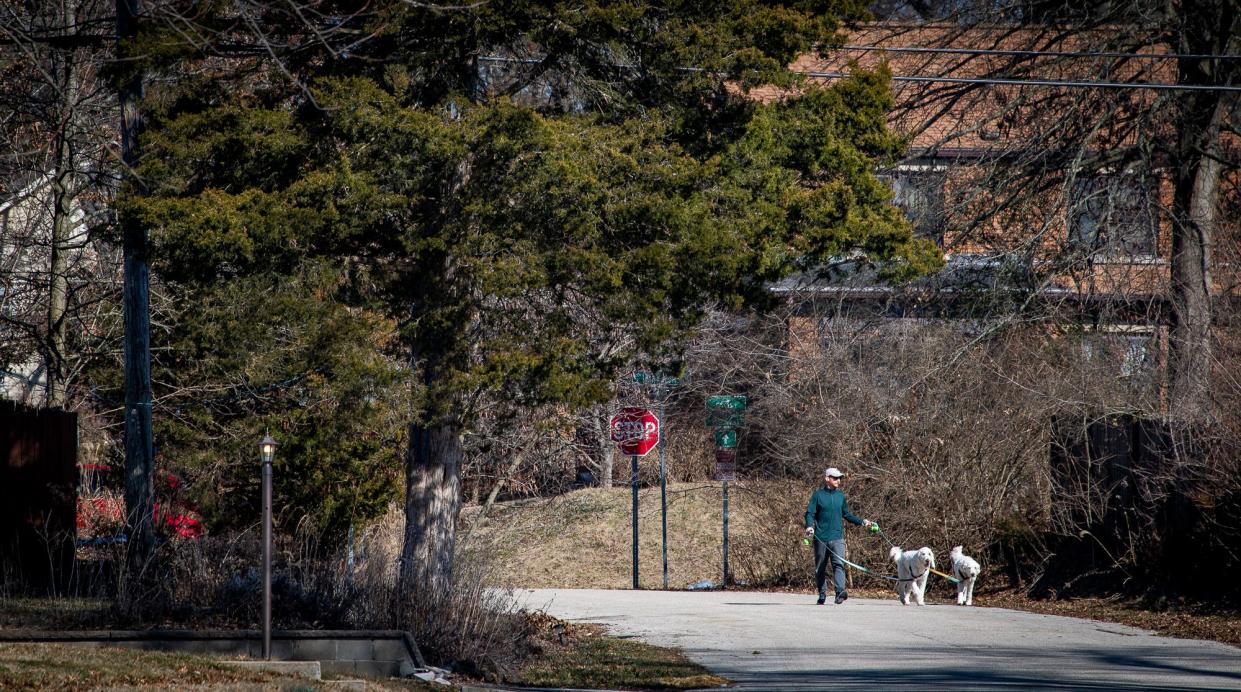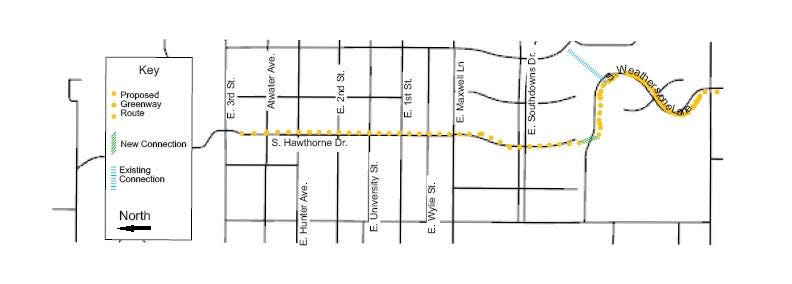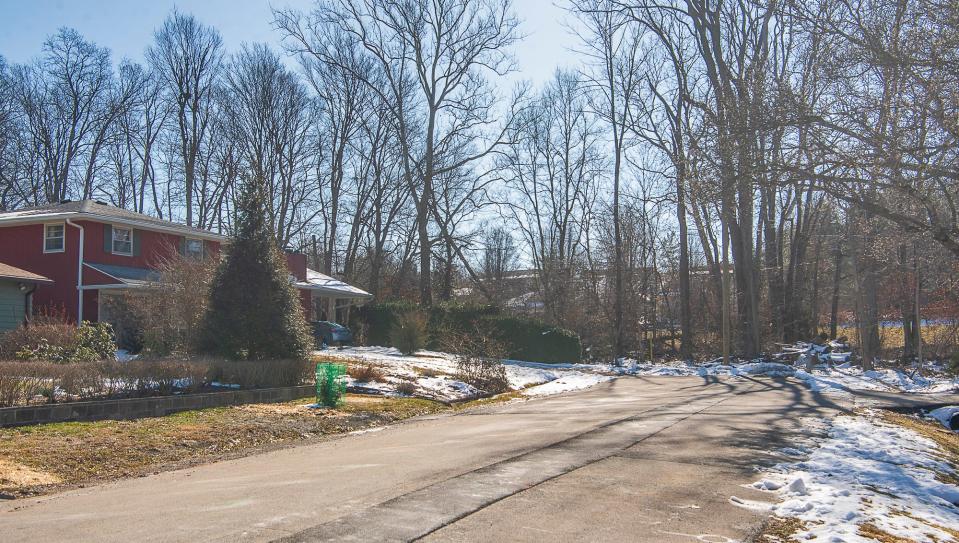Mayor: Hawthorne & Weatherstone greenway will proceed this year

- Oops!Something went wrong.Please try again later.
In a matter of weeks, construction is set to turn a north-south street south of the IU campus into a low-speed, low-volume shared space to make it safer and more inviting to pedestrians and cyclists.
Some neighbors in the affected area — south Hawthorne Drive and South Weatherstone Lane — oppose the project, called the Hawthorne & Weatherstone Neighborhood Greenway, and likely hoped new Mayor Kerry Thomson would undo what, as one opponent said, had been “foisted” upon them by the previous mayoral administration.
However, Thomson said Saturday in a community meeting she organized, the greenway is “foundational” to the city’s greenway network, the expansion of which originates in the city’s Transportation Plan, which the city council adopted in 2019.
In a presentation, the city said the Hawthorne/Weatherstone project is about “making a good space even better in order to increase walking and bicycling.”
But some residents in the area said the street already is safe and used frequently by cyclists and pedestrians, and the city’s plan represents a continuation of a cyclists-over-motorists ideology that disregards the residents’ lived experiences.
The clash over the Hawthorne & Weatherstone Neighborhood Greenway resembles disagreements between local government officials and residents on important topics including the future jail site, annexation and housing.
The Hawthorne meeting also saw familiar faces on opposite sides:
Bloomington City Council President Isabel Piedmont Smith opposed member Dave Rollo. For most of the last four years, the two have been part of opposing city council factions.
Long-time Bloomington residents opposed city officials.
Elm Heights resident Stephanie Hatton opposed Bloomington Traffic Commission member Greg Alexander. The two last year engaged in a months-long dispute over the installation of a stop sign and Alexander’s subsequent social media posts that included sexual innuendo. Rollo tried, unsuccessfully, to convince city council members to remove Alexander from the traffic commission. Both Hatton and Alexander attended Saturday’s meeting.
Where is Bloomington's Hawthorne & Weatherstone greenway?
The Hawthorne & Weatherstone Neighborhood Greenway will begin at the intersection of East Hillside Drive and South Weatherstone Lane, follow that lane north, connecting with South Hawthorne Drive and ending at its intersection with Third Street, which marks the beginning of the Indiana University campus. The project will include bump-outs, where the curb juts into the street, forcing drivers to reduce their speed.

The greenway project, at $450,000, was folded into related projects to reduce costs, Thomson said, as the final cost of $870,000 also includes traffic calming on Miller Drive, replacing invasive pear trees, new and improved signage, intersection improvements at Hillside and bringing some sidewalks and curbs into compliance with the Americans with Disabilities Act.
Thomson told attendees Saturday she called the meeting to see whether the city could do anything to improve the greenway’s implementation. While she said she understood “people aren’t happy” and said it was OK for them to be angry with her, she asked attendees to talk about facts and principles rather than blaming individuals and calling them names. Most attendees heeded her request.
Thomson also said she wanted input on how the city could improve the process by which greenways are implemented and communicated to residents, though she made clear that under her leadership, the Hawthorne Weatherstone project would move forward.
This did not sit well with some of the attendees, including Rollo and Bloomington City Council Vice President Andy Ruff.
Ruff said since Thomson already had made up her mind, the meeting was essentially just for show, though, he emphasized, the project remained a “future project” and planning orders could be halted.
Ruff acknowledged the area could use safety improvements, but said the proposed project was over the top. Residents are asking for more reasonable safety improvements, he said.
City council member: Greenway was 'foisted" on residents
Rollo, who has long criticized the project and the process by which it came about, reiterated he thought the greenway was a massive misallocation of resources, the data do not support its construction and the project had been “foisted” onto residents.
“These bump-outs, I think, are totally unnecessary, and they’re not appreciated by the people who live there,” he said.
He called the project a result of a “broken process” and repeated his call for a change; Rollo has put forth proposals for future greenways to be approved by the city council.

Leslie Hobbs-Ramsey also said the project was not necessary, would make the area less safe and had been pushed down the residents’ throats by a small number of unelected people. She also said the meeting was a waste of time as the mayor had decided the project was going forward.
Hobbs-Ramsey got pushback from Bloomington City Council President Isabel Piedmont-Smith, who said the greenway was part of the Transportation Plan, which was passed by the city council — not by unelected bureaucrats. Piedmont-Smith also criticized Rollo’s plan for council review of greenways as “flawed,” as council review at the end of a long process had the potential to waste a lot of administrative and constituent time.
Many people who attended or called into the meeting said they had questions about the process by which the project came about. Most opposed the project entirely or aspects of it, including its cost and the bump-outs.
Hatton said the data don’t support the need for bump-outs.
Amy Pickard said via the chat function that the bump-outs seemed dangerous and unnecessary. Carole Canfield asked, “What problem are we trying to solve here?”
Jeff Richardson, a Thomson supporter and former city council member, said the city should fix other treacherous areas in that part of the city before focusing on the greenway.
Chuck Livingston said he hadn’t seen a report on ADA compliance and would like to see if it had been done. He said the city’s transportation plan also does not give enough consideration to people in wheelchairs. He said the document mentions bicycles more than 1,000 times but wheelchairs aren't mentioned at all.
Livingston also said he lives in a neighborhood with many older people, who, because of the city’s deficient sidewalks, wonder not if, but when they will break a bone.
The city’s planning and engineering offices could not be reached Monday or Tuesday to say whether an ADA compliance report was necessary and/or had been completed and what data supported the use of bump-outs. In a public meeting in 2022, the city shared slides indicating motor vehicle speeds of about 15 mph create safer streets for all users, and higher speeds increased the frequency and severity of accidents.
“A risk of pedestrian fatality at an impact speed of 20 MPH is 10%, the risk of a pedestrian fatality at an impact speed of 40 MPH is 80% (this increases with SUVs and trucks),” the city wrote.
Traffic commission member: Greenway makes area much safer
Alexander, the traffic commission member, said he bikes with his kids and said low-traffic neighborhoods have fewer crashes and make cyclists much more comfortable. When cars go by at 30 mph, Alexander said he has to keep a sharp eye on his children, but when cars slow to 15 mph, it feels to him as though drivers are guests on the road.
That feeling, as a parent, is completely different, he said.
Alexander said the greenway will be important for people in his and other neighborhoods who are less likely to own cars than the residents of Elm Heights, a wealthy neighborhood that counts among its residents Hatton, current Mayor Thomson and former Mayor John Hamilton.
Alexander said pedestrians in poor neighborhoods now often walk in mud, on roads and are forced into unsafe behavior just because they’re impoverished. He said he wants to make sure people who do not have cars also have safe ways to get from one place to another.
Betty Rose Nagle said she understands that neighborhood residents where greenways are proposed do not have the final say over such projects, because sometimes the community’s need outweighs the neighbors’ concerns.
However, she said, too often, as in this case, the neighbors feel as though the city is trying to pull a fast one on them and, instead of reasoned discussions among the various interests, the neighbors' concerns are being disregarded.
“It’s true that we don’t own that street,” she said, “but it’s also true that we know that street.”
Boris Ladwig can be reached at bladwig@heraldt.com.
This article originally appeared on The Herald-Times: Bloomington neighborhood project faces pushback from Elm Heights

